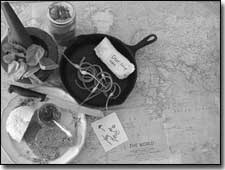|
by Chef Boy Ari

T wo years ago this August, a friend came over with
a bucket of apricots gleaned from an undisclosed tree.
Last week, the spicy chutney we made from those apricots
became the icing on a culinary trajectory that came to
fruition in the form of a sandwich.
But this story is about more than my sandwich. It's
about the possibility of local cuisine, a concept that
here in the West appears rarely to extend beyond fried
cow balls and chicken fried steak. This isn't France,
where centuries of careful experimentation with local
ingredients has led to a legendary cuisine. But maybe,
someday, our cuisine could rival that of France. Why
not? We have the raw ingredients for some fantastic food.
Gary Snyder once said, "You can't know who you are if
you don't know where you are." In other words, you are
part of the landscape. It's also been said that you are
what you eat. Indeed, the molecules that we ingest as
food are what our bodies are made of.
If you combine the above phrases, with a bit of verbal
algebra you can arrive at the semantic equation: You
can't know what you eat if you don't know where you are.
In other words: We eat our landscape. This used to be
truer than it is now, back when the Indians of the Southwest
were made of corn, Greeks were made of olives, and Eskimos
were made of seal. But today, people eat less and less
from the particular landscapes they inhabit.
The long-distance shipping of food makes many wonderful
things possible, like French, Japanese, or Thai food
here in America. In their spice mixtures, the preparation
of vegetables, and the overall combination of ingredients,
culinary traditions that have simmered slowly over the
years can produce flavor that is truly mind-expanding.
Beyond the exotic spices and fruits that you cannot produce
at home, these regional cuisines bring us methods, culture,
and place.
On the other hand, there is the bland side of long-distance
food shipping: food that tells you absolutely nothing
about place. Frozen pizza is not from Italy. Frozen jalapeno
poppers aren't from the Southwest. A Big Mac in Tokyo
will taste the same as in France, or Moscow.
Meanwhile, we all have the power, if not the responsibility,
to ask some simple questions. What can be grown and gathered
from my landscape? What culinary traditions, however
obscure, do we have? What more can we create, or borrow
from others?
Don't expect to turn around your food supply chain in
one stroke. It takes time. But like that apricot chutney,
many things improve with age. And little steps will accumulate,
if you take them. I'll now explain the preparation of
my aforementioned sandwich, in the form of a timeline.
August, 2002: Make apricot chutney.
October, 2002: Plant garlic for the following summer's
harvest.
July, 2003: Harvest garlic. Store it in my garage.
August, 2003: Buy hot and sweet peppers at the Farmer's
Market; pickle them in cider vinegar.
October, 2003: Plant more garlic for summer, 2004.
November, 2003: Shoot deer.
April, 2004: Plant spinach and cilantro.
June 21, 2004: Solstice day. Remove package of deer
from freezer and thaw. Buy bread from the local bakery.
Pick spinach, cilantro, and garlic flowers from this
year's crop. Mash cilantro in mortar and pestle with
garlic cloves from last year's crop (which is about to
run out). Rub the garlic/cilantro paste on the meat.
Pour soy sauce and vinegar from the pickled pepper jar
on the meat. Let sit.
Heat grapeseed oil in a pan and add chopped bacon (from
a farm down the valley). Fry the deer meat in the grease,
crispy on outside, rare inside. When it's almost done,
cut the meat into medallions, add garlic flowers and
spinach, stir-fry it all in the grease. Remove heat.
Toast bread. Spread apricot chutney on one slice, mayo
on the other. Remove meat medallions from pan and place
on the bread slice with the apricot chutney. Place spinach/garlic
flower mixture on top of meat. Pour grease from the pan
over everything, and put the mayo bread slice on top.
Serve with a glass of Farm Dog Red, from the local winery.
The only components of this meal that weren't from around
here were the mayo, soy sauce, and grapeseed oil. But
remember: These things could have been local. Soy beans
grow here. Grapes grow here. Chickens grow here too,
and where there are chickens, there is mayonnaise, not
to mention chicken fried steak!
Try your own local cuisine experiment, and see what
you come up with. As you eat your landscape, you become
evermore a part of it. Perhaps you will become more in
tune with your identity. At the very least, it will taste
really good.
|